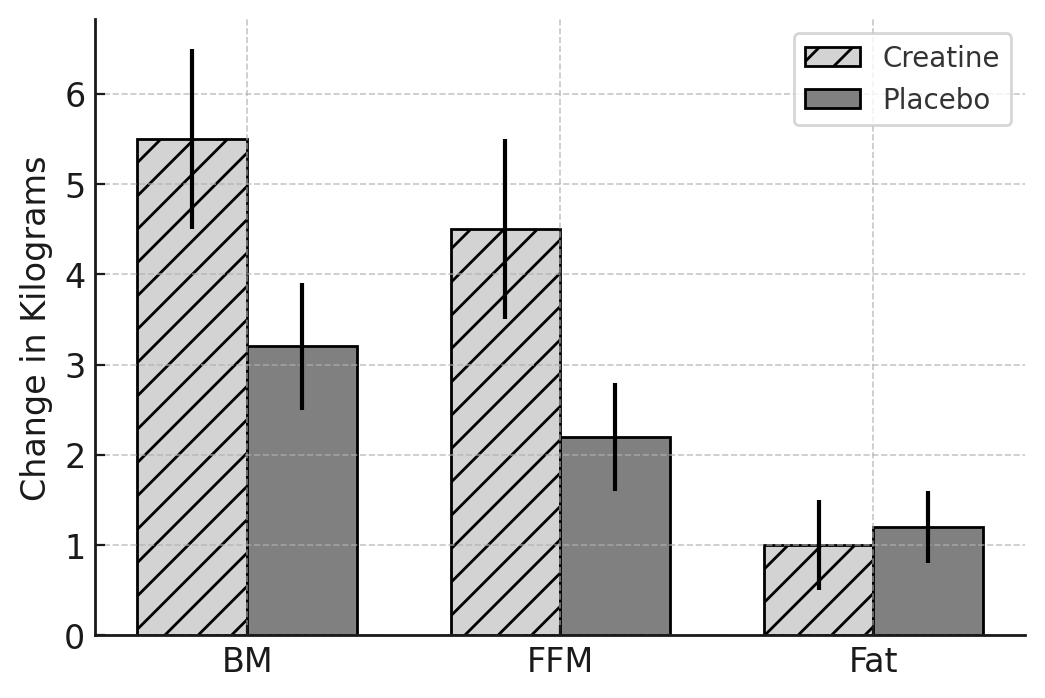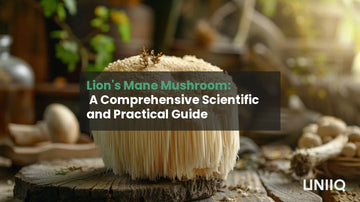Overview
Often deemed the “holy grail” of workout supplements, Creatine Monohydrate is one of the most widely researched and science backed supplement, proven to enhance muscle strength, power and growth. Unlike many popular supplements, the effects of creatine monohydrate are well-established and widely accepted.
Creatine is a compound derived from amino acids (building blocks of protein) and is naturally produced within the liver and kidneys. It is also found in certain meats and fish and is essentially stored in our muscle tissue. Its function is to provide our body and more specifically our muscles with energy during high-intensity workouts. Creatine supplementation is becoming increasingly more common as an average diet today might contain 1-2g of creatine per day, whilst our muscles require around 3-5g of creatine for full saturation.
In this article, we will dive deeper into this compound and explore its tremendous benefits, backed by scientific research. Whether you’re an avid bodybuilder, just starting your fitness journey, or an everyday individual looking to enhance performance, creatine monohydrate is a game-changing supplement.
How does Creatine work- (Mechanism)?
To fully understand how creatine works within our body, we need to take a closer look into its physiological mechanism. In other words, we need to understand what creatine does to our bodies and how it affects us.
Ultimately creatine´s benefits rely on the folloowing two mechanisms within our body:
1. 🔋 ATP Regeneration: ATP (Adenosine Triphosphate) is a crucial molecule which fuels our cells. Our bodies (cells) rely on ATP for power, especially during high intensity workouts where rapid energy is needed. ATP is often compared to a battery, as it releases its energy by removing one of three phosphate groups turning into ADP (Adenosine Diphosphate). The only issue is that ATP stores are quite limited and are quicky depleted during exercise. This is where creatine comes into play. Creatine gets stored within our muscle cells and is converted to phosphocreatine (PCr). This molecule donates phosphate to ADP and regenerates it to ATP. The result is sustained energy within our muscle cells and a delayed fatigue experience.
2A. 🧫 Cell Volumization (Osmotic hydration): A famous feature of creatine is its ability to draw water into the skeletal muscle cells (myocytes). It manages this by acting as a Osmolyte. Because of creatines osmotic properties it will draw water into the intracellular space, which in turn increases cell volume. This does a great number of things, however most notably it promotes muscle fullness, reduces muscle breakdown and overall enhances the muscles visually.
2B. 🧬 mTORC1 Pathway: As we established above creatine causes increased water pressure (intracellular pressure) within the cell. Consequently the muscle (myocytes) cells experiences great mechanical tension. This mechanical tension is comparable to the tension induced for the myocytes when we lift weights. As a result of this tension and stress, the cell activates the mTORC1 pathway. This is a molecular complex that is responsible for building protein, enhancing protein synthesis and in general promoting muscle growth (Hypertrophy). By stimulating this pathway, creatine supplementation supports muscle growth and strenght development.
Different Types of Creatine?
Creatine as a supplement exists in various forms with different properties and features, however, Creatine Monohydrate is considered the gold-standard for supplementation. This is due to various factors such as its bioavailability which is nearly a 100% (we can fully absorb and utilize it). Additionaly its the most cost-effective form without unnecessary additives and modifications.
Common forms of creatine include:
-
✅ Creatine Monohydrate (CrM)
-
❌ Creatine Hydrochloride (HCL)
-
❌ Creatine Ethyl Ester (CEE)
Why not alternatives?:
The alternatives to creatine monohydrate aim to "solve" some of the side effects with creatine monohydrate. However, there isnt enough research and factual evidence making any alternative a challenger to monohydrate. A systematic review from 2022 compared Creatine monohydrate to various creatine forms like - CEE, HCL and citrate. No alternatives to monohydrate showed any superior performance and are consistently more expensive and less bioactive than monohydrate (Fazio, Elder, and Harris (2022)
Bloating and stomach discomfort is a factor a lot of these varieties try to resolve, with no certain prevail. Varieties like Creatine Ethyl Ester (CEE) and Creatine Hydrochloride (HCL) aim to reduce this by improving the absorption of creatine, through their respective compositions. However, there is no strong evidence supporting these claims and enough research hasnt been conducted. Some of these forms have also been associated with increased creatine degradation into creatinine (Waste product).
Micronized Creatine:
Micronized creatine in simple terms is Creatine Monohydrate which has been mechanically processed into smaller particles. The purpose of micronizing creatine is to increase its solubility and mixability in water resulting in easier digestion for our body. This ultimately results in less bloating and water retention whilst still maintaining the efficacy of the Creatine. Micronized Creatine Monohydrate is the preferred and most widespread form of creatine monohydrate. Its important to keep in mind that Creatine supplements are considered micronized only when they are 200 mesh or finer or less than 75 microns thick.
📚 Read more: For most FAQ on micronized creatine, see this article from Pi nutrition: Micronized Creatine 101 what is it and why its important.
Common misconceptions about Creatine?
Despite creatine being one of the most science backed and researched supplement, there are still a few common misconceptions regarding it. It’s important to remember that these claims are often based on anecdotal evidence and personal experiences, with little scientific backing to support them.
Some of the more common misconceptions include:
-
Kidney toxicity
-
Bloating or excessive water retention “Water Weight”
-
Loading phase is necessary
-
Mainly for bodybuilders
🩸 Kidney toxicity:
Kidney toxicity has been a concern with creatine supplementation, mainly based on the fact that creatine is metabolized and excreted by the kidneys. However, this is a common misconception and several studies have debunked this hypothesis. In fact a large Meta-analysis from 2019 which pooled data from 290 different studies found no change in biomarkers like creatinine and plasma urea (kidney markers) indicating no renal (kidney damage). The study spanned typical creatine dosaging, with both loading and maintenance dosages (3-20g a day) (de Guingand et al., 2019).
💧 Water Retention/Bloating:
When we consider creatines ability to draw water into our cells, side effects like bloating/water retention isn´t hard to imagine. However this is a common misconception, as the water that creatine attracts is directed into our muscle cells. This is different than water retention subcutaneously (under the skin) which would then cause visible bloating. A randomized, placebo controlled study conducted in 2020 aimed to examine the TBW (Total body water), intracellular, extracellular water change with creatine supplementation. The study found that intracellular water increased more significantly with creatine supplementation rather than placebo (Muscle cell volume). The study also confirmed that ECW increased similarly in both groups, indicating no excess bloating/water retention from creatine supplementation.
🚀 Loading phase:
a loading phase with creatine supplementation being necessary is a common misconception, due to the fact that it can be beneficial. The loading phase of creatine supplementation, consists of taking a higher dose for around 5-7 days to quickly saturate the musccles with creatine. The result of this loading phase is that the muscles are saturated faster, however the same results are achieved with the standard recommended dosing, just over a longer time period.
🏋 Mainly for Bodybuilders:
Creatine is often associated with bodybuilders and hardcore gym-goers due to its obvious muscle enhancing effects. However as we will explore further, creatines benefits isnt limited to only muscle enhancement. We know that creatine can increase ATP regeneration and there has also researched The supplement can be utilized by many demographic groups, which are following:
-
🚲 Endurance Athletes (Sprinters, Cyclists Football players)
-
🧑🏻🎓 Students/Professionals (Due to Cogonitive benefits)
-
💪Muscle wasting diseases (Sarcopenia, myscular dystrophy etc)
-
🌱Vegetarians and vegans (Due to low creatine in diet)
📚 For a more detailed explanation and breakdown of misconceptions regarding creatine supplementation, see this article from Sci-sport: Creatine and its myths: what does science have to say?
Benefits of Creatine Supplementation?
The foundation of creatines vast benefits, is through its mechanisms within our body. Uniquely, creatines benefits are backed and endorsed by countless scientific research and studies. Below are some of the benefits often experienced with creatine supplementaitions:
💥 Increased Strength & Power:
Increased strenght and power is creatine´s most infamous benefit and the reason majority of gym-goers supplement with creatine monohydrate. As we established, the main reason for the increase in strength and short burst energy is due to creatines ATP regenerative properties.
A double-blind placebo controlled RCT (Randomized clinical trial) conducted in 2021, saught out to analyze the long terms effect of creatine supplementation combined with resistance training. The participants recieving creatineo saw on average a 20% increase in maximal strength (1RM) compared to only 10% with the placebo. During the 5 weeks of the study, creatine provided a doubling of strength in 1RM compared to the placebo, proving undoubtedly the signficant benefits of creatine. (Rashti et al., 2021)
💪🏻 Muscle Hypertrophy (Growth):
Muscle Growth (Hypertrophy) is another major benefit seen with creatine supplementation. As we established, the growth has to do with creatines osmolytic properties and the pathways it activates within muscle cells. These mechanisms ultimately provide an environment for cellular growth and combined with resistance training it can increase muscle mass significantly.

A randomized double-blind placebo controlled trial examined the effects of 12 weeks of a resistance training program with and without creatine supplementation. The results of the extensive study was a 6,3% increase in fat-free mass (Mainly skeletal muscle) with the creatine supplemented group compared to 3,1% in the placebo group. Additionally, muscle fiber hypertrophy was also significantly greater with the creatine group showing an average 35% increase compared to 6-15% average wit the placebo group. Finally, the group that recieved creatine supplementation also experienced greater improvements in 1RM (Rep Max) compared to the placebo group (Volek et al., 1999).
🧠 Cognitive benefits:
Beyond strength and energy benefits, a lesser known feature of creatine supplementation is its promising brain enhancing effects. Several studies have linked its mechanism within the brain to effects such as; increased cognitive function, neuroprotective properties and improved mood.
Within the brain, creatine gets phosphorylated to Phosphocreatine a derivative of creatine. This molecule acts as a energy reserve by donating phosphate to ADP to turn it into ATP (main energy currency). Simultaneously creatine has also been shown to reduce oxidative stress, further promoting homeostasis in the brain.
📚 For a bigger overview on creatines health benefits, visit healthlines article: 10 Health and Performance Benefits of Creatine.
How to take Creatine?
When taking creatine as a supplement there are a few key factors to keep in mind to maximize the potential benefits as well as to reduce potential side effects.
⚖️ Creatine Dosage:
The exact dosage of creatine is dependent on factors such as your training goals, body weight and muscle mass.
One way of calculating the dosage of creatine is based on body weight, keep in mind that height as a factor here is irrelevant. A dosage of 0,03g per kg of body weight is frequently used for those who want to be as precise as possible with the dosing. Particularly heavier individuals might fall out of the average dosage range and therefore want to be more precise with the dosage.
The standard approach of creatine monohydrate dosage is around 3-5 grams per day. This dosage is known as the maintenance dose and is considered safe and is the most studied in terms of side effects and efficacy.
⏱️ When to take creatine (Timing):
As a general rule you can take creatine at any time of the day. However there is some research indicating potential benefits when it is taken at specific times;
-
Post-workout: Due to the fact that the muscles might be more receptive to uptake
-
Pre-workout: To ensure the availabilty during workout
-
With a meal: Insulin spikes with food have potential to enhance absorption further
Timing with creatine supplementation is not considered crucial. Consistency and regular supplementation however, is very important to ensure proper saturation of the muscles and to achieve the desired effects of creatine.
🥤 How to take it:
Creatine is often mixed with water, juices or protein shakes. Generally there isnt any strictly recommendated liquid to dissolve it in, however there are some potential benefits when mixed with certain liquids:
-
Water: Especially warm water as it helps dissolve the creatine more easily, which will then reduce any grainy texture the creatine might have.
-
Juice: Due to the often high sugar content in juices, the insulin spike we recieve can help enhance the absorption of creatine by making the transport of creatine into muscle more efficient.
-
Protein shakes/Pre workouts: While this doesnt have any effects on the creatine itself, its common to mix it into protein shakes for convenience.
Important considerations:
Creatine monohydrate supplementation is generally considered quite safe, due to the extensive research and studies conducted. There are however certain considerations to keep in mind when supplementing:
-
Water retention: Due to the fact that creatine draws water into the msucle cells, it can periodically lead to a slight increase in body weight.
-
Keep Hydrated: Creatines ability to draw water within the muscle cells can make us feel dehydrated, however, drinking adequate amounts of water can counter this.
-
Stomach distress: Some people experience bloating and stomach discomfort when using creatine. Reducing/splitting the doses can often help counter this.
-
Kidney complications: Although most research has denied any impactful kidney damage with creatine, if you have pre-existing kidney complications, consulting a doctor is advised.
Summary and Conclusion:
Creatine Monohydrate is one of the most researched and effective supplements for improving strength, muscle growth, and even cognitive function. The recommended dosage is generally 3-5g daily, with an optional loading phase of 20g per day for 5-7 days to potentially speed up muscle saturation. Creatine can be taken at any time, though post-workout or with meals may help enhance absorption.
Simply mix it with water, juice, or a protein shake for easy intake. While it may cause mild water retention or stomach discomfort in some, staying hydrated and adjusting your dose can minimize these side effects. Creatine Monohydrate remains the gold standard for its proven effectiveness, affordability, and safety for most individuals.








